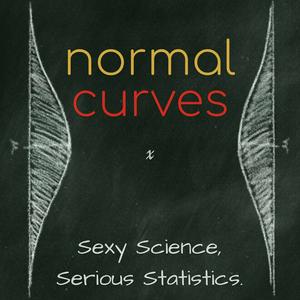P-Values: Are we using a flawed statistical tool?
P-values show up in almost every scientific paper, yet they’re one of the most misunderstood ideas in statistics. In this episode, we break from our usual journal-club format to unpack what a p-value really is, why researchers have fought about it for a century, and how that famous 0.05 cutoff became enshrined in science. Along the way, we share stories from our own papers—from a Nature feature that helped reshape the debate to a statistical sleuthing project that uncovered a faulty method in sports science. The result: a behind-the-scenes look at how one statistical tool has shaped the culture of science itself.Statistical topicsBayesian statisticsConfidence intervals Effect size vs. statistical significanceFisher’s conception of p-valuesFrequentist perspectiveMagnitude-Based Inference (MBI)Multiple testing / multiple comparisonsNeyman-Pearson hypothesis testing frameworkP-hackingPosterior probabilitiesPreregistration and registered reportsPrior probabilitiesP-valuesResearcher degrees of freedomSignificance thresholds (p < 0.05)Simulation-based inferenceStatistical power Statistical significanceTransparency in research Type I error (false positive)Type II error (false negative)Winner’s CurseMethodological morals“If p-values tell us the probability the null is true, then octopuses are psychic.”“Statistical tools don't fool us, blind faith in them does.”ReferencesNuzzo R. Scientific method: statistical errors. Nature. 2014 Feb 13;506(7487):150-2. doi: 10.1038/506150a. Nuzzo, R., 2015. Scientists perturbed by loss of stat tools to sift research fudge from fact. Scientific American, pp.16-18.Nuzzo RL. The inverse fallacy and interpreting P values. PM&R. 2015 Mar;7(3):311-4. doi: 10.1016/j.pmrj.2015.02.011. Epub 2015 Feb 25. Nuzzo, R., 2015. Probability wars. New Scientist, 225(3012), pp.38-41.Sainani KL. Putting P values in perspective. PM&R. 2009 Sep;1(9):873-7. doi: 10.1016/j.pmrj.2009.07.003.Sainani KL. Clinical versus statistical significance. PM&R. 2012 Jun;4(6):442-5. doi: 10.1016/j.pmrj.2012.04.014.McLaughlin MJ, Sainani KL. Bonferroni, Holm, and Hochberg corrections: fun names, serious changes to p values. PM&R. 2014 Jun;6(6):544-6. doi: 10.1016/j.pmrj.2014.04.006. Epub 2014 Apr 22. Sainani KL. The Problem with "Magnitude-based Inference". Med Sci Sports Exerc. 2018 Oct;50(10):2166-2176. doi: 10.1249/MSS.0000000000001645. Sainani KL, Lohse KR, Jones PR, Vickers A. Magnitude-based Inference is not Bayesian and is not a valid method of inference. Scand J Med Sci Sports. 2019 Sep;29(9):1428-1436. doi: 10.1111/sms.13491. Lohse KR, Sainani KL, Taylor JA, Butson ML, Knight EJ, Vickers AJ. Systematic review of the use of "magnitude-based inference" in sports science and medicine. PLoS One. 2020 Jun 26;15(6):e0235318. doi: 10.1371/journal.pone.0235318. Wasserstein, R.L. and Lazar, N.A., 2016. The ASA statement on p-values: context, process, and purpose. The American Statistician, 70(2), pp.129-133.Kristin and Regina’s online courses: Demystifying Data: A Modern Approach to Statistical Understanding Clinical Trials: Design, Strategy, and Analysis Medical Statistics Certificate Program Writing in the Sciences Epidemiology and Clinical Research Graduate Certificate Program Programs that we teach in:Epidemiology and Clinical Research Graduate Certificate Program Find us on:Kristin - LinkedIn & Twitter/XRegina - LinkedIn & ReginaNuzzo.com(00:00) - Intro & claim of the episode
(01:00) - Why p-values matter in science
(02:44) - What is a p-value? (ESP guessing game)
(06:47) - Big vs. small p-values (psychic octopus example)
(08:29) - Significance thresholds and the 0.05 rule
(09:00) - Regina’s Nature paper on p-values
(11:32) - Misconceptions about p-values
(13:18) - Fisher vs. Neyman-Pearson (history & feud)
(16:26) - Botox analogy and type I vs. type II errors
(19:41) - Dating app analogies for false positives/negatives
(22:02) - How the 0.05 cutoff got enshrined
(23:46) - Misinterpretations: statistical vs. practical significance
(25:22) - Effect size, sample size, and “statistically discernible”
(25:51) - P-hacking and researcher degrees of freedom
(28:52) - Transparency, preregistration, and open science
(29:58) - The 0.05 cutoff trap (p = 0.049 vs 0.051)
(30:24) - The biggest misinterpretation: what p-values actually mean
(32:35) - Paul the psychic octopus (worked example)
(35:05) - Why Bayesian statistics differ
(38:55) - Why aren’t we all Bayesian? (probability wars)
(40:11) - The ASA p-value statement (behind the scenes)
(42:22) - Key principles from the ASA white paper
(43:21) - Wrapping up Regina’s paper
(44:39) - Kristin’s paper on sports science (MBI)
(47:16) - What MBI is and how it spread
(49:49) - How Kristin got pulled in (Christie Aschwanden & FiveThirtyEight)
(53:11) - Critiques of MBI and “Bayesian monster” rebuttal
(55:20) - Spreadsheet autopsies (Welsh & Knight)
(57:11) - Cherry juice example (why MBI misleads)
(59:28) - Rebuttals and smoke & mirrors from MBI advocates
(01:02:01) - Winner’s Curse and small samples
(01:02:44) - Twitter fights & “establishment statistician”
(01:05:02) - Cult-like following & Matrix red pill analogy
(01:07:12) - Wrap-up



